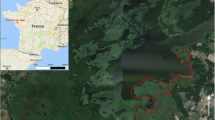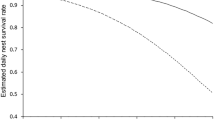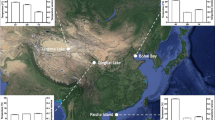Abstract
In bird species, one of the trade-offs between reproduction and survival appears in the parental decision to desert the nest. Nest desertion is modulated by several factors including clutch size. However, the incubation stage at which predation occurs is also an important factor. In this study, we examined whether nest desertion was linked to initial clutch size, partial clutch predation (final clutch size) and the incubation stage at which it happened in a capital breeder: the female common eider (Somateria mollissima) nesting in the high Arctic. The study was performed in Kongsfjorden in 2002 on the western coast of the Svalbard Archipelago (78°55′N, 20°07′E). We observed that nest desertion was higher when the initial clutch size was small. Also, females deserted their nests more during the first third of incubation than later. Thus, as incubation proceeded, nest desertion was less likely to occur even after egg reduction. Our results pointed out that this parental decision in female eiders seemed to depend on initial clutch size and on the date into incubation of clutch reduction.



Similar content being viewed by others
References
Ackerman JT, Eadie JM (2003) Current versus future reproduction: an experimental test of parental investment decisions using nest desertion by mallards (Anas platyrhynchos). Behav Ecol Sociobiol 54:264–273
Ackerman JT, Eadie JM, Yarris GS, Loughman DL, McLandress MR (2003) Cues for investment: nest desertion in response to partial clutch depredation in dabbling ducks. Anim Behav 66:971–883
Armstrong T, Robertson RJ (1988) Parental investment based on clutch value: nest desertion in response to partial clutch loss in dabbling ducks. Anim Behav 36:941–943
Bustnes JO, Erikstad KE (1991) Parental care in the common eider (Somateria mollissima): factors affecting abandonment and adoption of young. Can J Zool 69:1538–1545
Carlisle TR (1982) Brood success in variable environments: implications for parental care allocation. Anim Behav 30:824–836
Carlisle TR (1985) Parental response to brood size in a cichlid fish. Anim Behav 33:224–238
Clutton-Brock TH (1991) The evolution of parental care. Princeton University Press Princeton
Coleman RM, Gross MR (1991) Parental investment theory: the role of past investment. Trends Ecol Evol 6:404–406
Criscuolo F (2001) Does blood sampling during incubation induce nest desertion in the female Common Eider Somateria mollissima? Mar Ornithol 29:19–22
Criscuolo F, Gauthier-Clerc M, Gabrielsen GW, Le Maho Y (2000) Recess behaviour of the incubating Common Eider Somateria mollissima. Polar Biol 23:571–574
Criscuolo F, Gabrielsen GW, Gendner J-P, Le Maho Y (2002) Body mass regulation during incubation in female common eiders Somateria mollissima. J Avian Biol 33:83–88
Curio E (1988) Relative realized lifespan and delayed cost of parental care. Am Nat 131:825–836
Dawkins R, Carlisle TR (1976) Parental investment, mate desertion and a fallacy. Nature 262:131–133
Erikstad KE, Bustnes JO, Moum T (1993) Clutch-size determination in precocial birds: a study of the common eider. Auk 110:623–628
Erikstad KE, Tveraa T (1995) Does the cost of incubation set limits to clutch size in the Common Eider Somateria mollissima? Oecologia 103:270–274
Fernandez GJ, Reboreda JC (2000) Egg losses and nest desertion in greater rheas Rhea americana. Ibis 142:29–34
Forslund P (1993) Vigilance in relation to brood size and predator abundance in the barnacle goose, Branta leucopsis. Anim Behav 45:965–973
Gabrielsen GW, Melhum F, Karlsen HE, Andresen Ø, Parker H (1991) Energy cost during incubation and thermoregulation in the female Common Eider Somateria mollissima. Norsk Polarinstitutt Skrifer 195:51–62
Hanssen SA, Engebretsen H, Erikstad KE (2002) Incubation start and egg size in relation to body reserves in the common eider. Behav Ecol Sociobiol 52:282–288
Hanssen SA, Erikstad KE, Johnsen V, Bustnes JO (2003) Differential investment and costs during avian incubation determined by individual quality: an experimental study of the common eider (Somateria mollissima). Proc R Soc B 270:531–537
Kilpi M, Öst M, Lindström K, Rita H (2001) Female characteristics and parental care mode in the crèching system of eiders, Somateria mollissima. Anim Behav 62:527–534
Korschgen CE (1977) Breeding stress of female Eiders in Maine. J Wildlife Manage 41(3):360–373
Mehlum F (1991) Egg predation in a breeding colony of the Common Eider Somateria mollissima in Kongsfjorden, Svalbard. Norsk Polarinstitutt Skrifer 195:37–45
Monaghan P, Uttley JD, Burns MD, Thaine C, Blackwood J (1989) The relationship between food supply, reproductive effort and breeding success in Arctic terns Sterna paradiaea. Ardea 80:71–82
Montgomerie RD, Weatherhead PJ (1988) Risks and rewards of nest defence by parent birds. Q Rev Biol 63:167–187
Nilsson JA, Svensson M (1996) The cost of reproduction: a new link between current reproductive effort and future reproductive success. Proc R Soc B 263:711–714
Parker H, Holm H (1990) Patterns of nutrient and energy expenditures in female common eider nesting in the high Arctic. Auk 107:660–668
Pöysä H, Virtanen J, Milonoff M (1997) Common golden eyes adjust maternal effort in relation to prior brood success and not current brood size. Behav Ecol Sociobiol 40:101–106
Pugesek BH (1990) Parental effort in the California gull: tests of parent-offspring conflict theory. Behav Ecol Sociobiol 27:311–315
Pugesek BH, Diem KL (1990) The relationship between reproduction and survival in known-aged California gulls. Ecology 71:811–817
Schindler M, Lamprecht J (1987) Increase of parental effort with brood size in a nidifugous bird. Auk 104:688–693
Sedinger JS, Raveling DG (1990) Parental behavior of cackling Canada geese during brood rearing: division of labor within pairs. Condor 92:174–181
Slagsvold T (1982) Clutch size variation in passerine birds: the nest predation hypothesis. Oecologia 54:159–169
Stearns SC (1992) The evolution of life histories. Oxford University Press Oxford
Verboven N, Tinbergen JM (2002) Nest desertion: a trade-off between current and future reproduction. Anim Behav 63:951–958
Williams GC (1966) Natural selection, the costs of reproduction, and a refinement of Lack’s principle. Am Nat 100:687–690
Winkler DW (1987) A general model for parental care. Am Nat 130:526–543
Winkler DW (1991) Parental investment decision rules in tree swallows: parental defense, abandonment, and the so-called Concorde Fallacy. Behav Ecol 2:133–142
Yoccoz NG, Erikstad KE, Bustnes JO, Hanssen SA, Tveraa T (2002) Costs of reproduction in common eiders (Somateria mollissima): an assessment of relationships between reproduction based on observational and experimental studies. J Appl Stat 29(1–4):57–64
Acknowledgments
This work was supported by the Institut Polaire Français Paul Emile Victor, the Norwegian Polar Institute and the CEPE-CNRS. The programme was also funded by grants from the Singer-Polignac Foundation. The authors wish to thank Wojtek Moskal and the staff of the Norwegian Polar Research Station in Ny-Ålesund for technical support. The experiments have been conducted with the authorization of the French and Norwegian Ethics Committees and the Governor of Svalbard.
Author information
Authors and Affiliations
Corresponding author
Additional information
Sophie Bourgeon and Francois Criscuolo contributed equally to the work
Rights and permissions
About this article
Cite this article
Bourgeon, S., Criscuolo, F., Bertile, F. et al. Effects of clutch sizes and incubation stage on nest desertion in the female Common Eider Somateria mollissima nesting in the high Arctic. Polar Biol 29, 358–363 (2006). https://doi.org/10.1007/s00300-005-0064-7
Received:
Revised:
Accepted:
Published:
Issue Date:
DOI: https://doi.org/10.1007/s00300-005-0064-7




